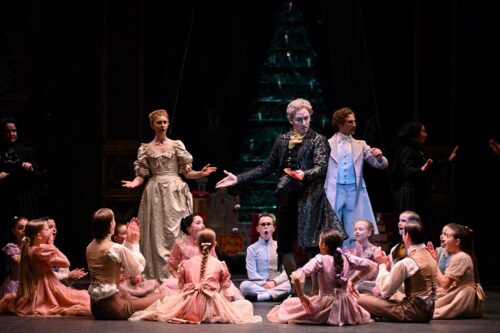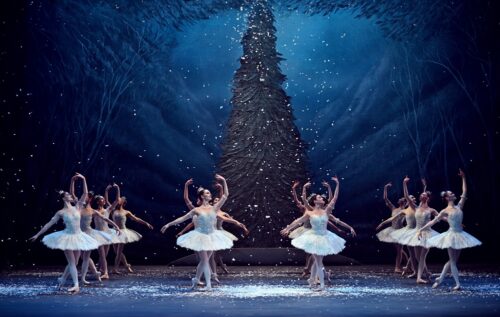 United Kingdom English National Ballet’s Nutcracker: Dancers of English National Ballet, Students from Tring Park School, English National Ballet Philharmonic / Timothy Henty (conductor). London Coliseum, London, 21.12.2021. (JPr)
United Kingdom English National Ballet’s Nutcracker: Dancers of English National Ballet, Students from Tring Park School, English National Ballet Philharmonic / Timothy Henty (conductor). London Coliseum, London, 21.12.2021. (JPr)

Production:
Choreography – Wayne Eagling
Designs – Peter Farmer
Lighting – David Richardson
Principal Dancers:
Clara – Maria Kochetkova
Nephew – Isaac Hernández
Nutcracker – Fernando Carratalá Coloma
Drosselmeyer – Fabian Reimair
Mouse King – William Simmons
‘It’s beginning to look a lot like Christmas’ is a Michael Bublé song you hear endlessly at this time of year. Looking and feeling like it’s Christmas is a distant memory in the UK (and many cities around the world) in 2021 because a zero-Covid strategy seems to have won the argument over those advocating the common sense of learning to live with the virus now huge swathes of the population are triple jabbed. Usually, Nutcracker is the harbinger of the festivities to follow but the heart sank at having to show an NHS Covid Pass to gain entry to the London Coliseum and sit throughout with a mask on (though apparently not needed if you have drink in your hand). Having heard the chorus are now masked at Covent Garden I feared the dancers might have been too; thankfully they weren’t (nor were the choir we heard during the glistening Land of Snow scene).
I haven’t seen Wayne Eagling’s Nutcracker for English National Ballet live onstage for five years. There was the overall excellence of the dancing you can rely on from Tamara Rojo’s company, and it remains a box office banker – even in these uncertain times – but it is showing its age and it would be good to have something new soon. As is well known, the ballet’s origins are in E.T.A. Hoffmann’s original 1816 story The Nutcracker and the Mouse King. Though what we see today differs in where it is located and other details, the plot remains basically the same: the story of a young girl who dreams of a Nutcracker Prince and a fierce battle against a Mouse King. When Marius Petipa first choreographed the ballet, he based it on a version by Alexander Dumas.
Give or take a few novel twists we begin with Clara’s family hosting a party for family and friends on Christmas Eve in their palatial (here Victorian) home. There is always an extravagant Christmas tree and in its shadow their children, Clara and Freddie, are dancing and playing as the guests arrive. For their 2010 production (based on an earlier one for Dutch National Ballet) Eagling and Toer van Schayk’s concept introduces their own subtle changes to a familiar plot: an old family friend, Dr Drosselmeyer arrives bringing along his nephew, a handsome soldier, sometimes Drosselmeyer might be a skilled clock and toy maker, however here he is just a children’s entertainer with his magic and puppet theatre. The children get their presents from St Nicholas and Drosselmeyer gives Clara a beautiful nutcracker doll which she adores but – boys being boys – a jealous Freddie breaks it. Drosselmeyer manages to quickly repair it and with the evening growing late, guests depart and the children go to bed.
The Mouse King haunts Clara’s dreams and as the clock strikes midnight strange things begin to happen. The living room fills with an army of giant rats and mice, led by the fierce king. The Nutcracker becomes a dashing soldier and leads his army of toy soldiers into battle in which they come out second best. The Mouse King faces off with the Nutcracker who gets injured and had to be rescued by Clara. The room is turned into the Land of Snow and Clara dances with the Nutcracker who morph into Drosselmeyer’s nephew. Eventually, Clara, the nephew and Drosselmeyer escape in a balloon (with the Mouse King clinging on) and land – for some reason – inside a huge version of the puppet theatre.
It doesn’t make a great deal of sense but by this time you are just sitting back and enjoying some of the spectacle. The Mouse King is finally defeated and Drosselmeyer becomes the master of ceremonies for some celebratory dances. As the finale to these, the Sugar Plum Fairy (Clara) and her Prince (the nephew) dance their grand pas de deux. The epilogue has Clara waking up and together with Freddie waving goodbye to the departing guests.
Here it is not the gift of the nutcracker doll but the handsome young man which is the catalyst that stirs prepubescent thoughts of adult love in young Clara (Amelia Clark). The significant moment in Act I is when she dances with him at the party and later dreams about him, conflating him with the toy she has been given. Eagling has combined two female roles into one; the innocent Clara and the more sophisticated and womanly Sugar Plum Fairy while at the same time splitting the male roles into two with separate dancers as the Nutcracker and the nephew (who becomes the Prince). Unfortunately seeing a grown man dance with a young girl who is also the focus of an older man’s attentions raises an eyebrow now in 2021 though it won’t matter (or should it?) to the youngest members of the ENB’s audience.
Basically, Eagling gives us a teen romance with a few allusions to Hoffmann in Peter Farmer’s quaint or magical settings. It still takes an age to get going and was undermined when Drosselmeyer (Fabien Reimair) fluffed the first trick, though everything else went smoothly for him. (Later some of the stage effects, as well as the sets and costumes showed their age.). Kudos to ENB for allowing the full participation of children in the performance (unlike The Royal Ballet’s The Nutcracker review here). Despite those children being a little annoying it is good how even the most minor character in the large cast populating the party – whether children or adults – is given something to do rather than just standing idly by. The Grandfather – the wonderful Michael Coleman who danced in the first ever Nutcracker I saw at Covent Garden in 1977 – spends a lot of time using his stick seemingly trying to look under another male character’s kilt (at least that is how it looked).
If you haven’t seen this Nutcracker do go if only to celebrate ENB being back at the London Coliseum after the recent difficult times. Once the helter-skelter antics at party was out of the way I thoroughly enjoyed, as ever, the commitment and technical accomplishment of the dancers whether as individuals, in more ensemble moments or as the well-drilled, stylish and impeccably synchronised corps de ballet.
There were solid – occasionally exceptional – performances from the youngest Tring Park students (Amelia Clark and Rudy Walding as the younger Clara and Freddie) to the most senior Lead Principals and no one should forget the importance of Tchaikovsky’s wonderful score well-played by the always reliable English National Ballet Philharmonic under Timothy Henty; even though on this occasion they seemed slightly slow to warm to their task.

Hidden behind a mask he wore throughout Fernando Carratalá Coloma was – in the very best sense – pleasingly wooden as the Nutcracker; Fabian Reimair was the avuncular Drosselmeyer even though – for reasons hinted at above – he seemed slightly more sinister than before; and William Simmons was the hyperactive Mouse King, the pantomime villain of this Nutcracker. The Snowflakes shimmered and the second act divertissements were well done by all concerned: Jung ah Choi, Chloe Keneally, Daniel McCormick were exuberant in the Spanish Dance, there was a suitably slinky quartet for the Arabian Dance (a shadow of what it once was and all the better for it), and the trio in the Chinese Dance were ebullient, though ENB seems to have ignored the recent debate about their brief contribution. The Mirliton Dance is simply a (very) languid solo for Julia Conway (assisted by Reimair’s Drosselmeyer) and looks as if it belongs to another ballet, but full marks to Noam Durand’s pyrotechnics as he led the Russian Dance with his energetic leaping and spinning. Precious Adams and Angela Wood caught the eye during the fragrant Waltz of the Flowers.
As the older Clara, Maria Kotchetkova (re-)announced herself as possibly the ENB’s leading ballerina with her Russian training evident from her pliant torso, her eloquent arms and hands allied to soft, supple footwork. This reached its zenith in the grand pas de deux as the Sugar Plum Fairy when she was as sparkling (as the celeste), secure, and commanding, if just a touch glacial which also could, I suspect, be her Russian background. Earlier Kotchetkova was also a very believable young girl, playfully innocent and for whom the world Drosselmeyer conjures up for her is full of wonder and excitement. Isaac Hernández as the nephew/ardent Prince partnered her impeccably and he showed off his good jump, clean landings and quicksilver turns, though I thought his dancing overall was slightly underpowered.
Jim Pritchard
